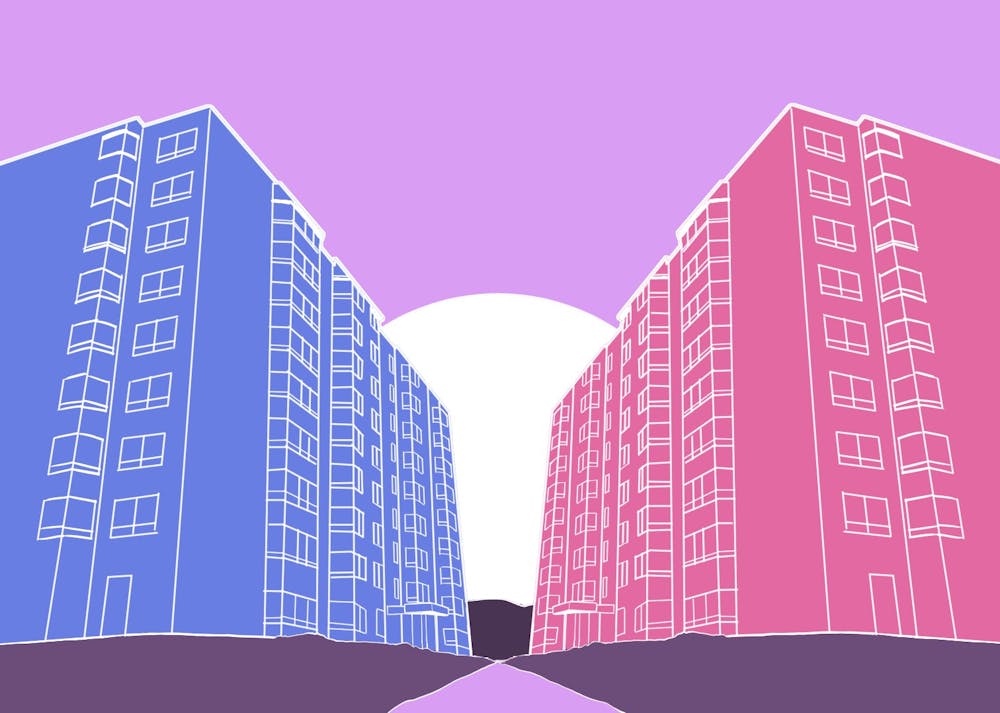Sakura Thomas emailed ASU Housing on Jan. 8, requesting gender inclusive housing for the upcoming school year, a dorming option for students who prefer to choose their roommate regardless of biological sex.
Thomas, a junior who uses she/they pronouns, encountered negative housing arrangements before. They had lived with roommates where they sensed apparent differences in gender identity, and in basic beliefs on identity and sexuality. A feeling of alienation and displacement clouded the school year as a result.
"To keep (my roommates) comfortable, I isolated myself," Thomas said.
For Thomas, applying for gender inclusive housing meant freedom. It meant finally finding a place where they could freely express themselves.
But nearly a month went by — past the assigned housing lottery date Thomas was given — before the housing department email came, leaving her to cycle through the same housing system that had failed her before.
ASU's gender inclusive housing process fell under fire yet again in the past year for scattered responses and failed arrangements for LGBTQ+ students and brought further attention to consistent failures in communication across the entire housing department.
Gender Inclusive Housing
For students like Thomas without strong personal connections to the housing department or LGBTQ+ resources on campus, the entire process remained a mystery.
The seemingly endless wait, the lack of guarantee for gender inclusive accommodations and the absence of transparency on the process's wait times and room choice left many LGBTQ+ students feeling confused and endangered.
In September 2020, the Rainbow Coalition and the Barrett LGBTQ+ Club launched a petition demanding urgent gender inclusive housing reform. According to the petition, the clubs had been in contact with the ASU housing department for months, but had not seen any change to the process they deemed, "almost completely dysfunctional."
Before calls for reform, students would email housing, request an application, fill out the application and wait, sometimes months, for housing to randomly assign a dorm and roommate.
Some signatures on the petition included notes on personal experiences with ASU housing and the gender inclusive housing process. One student noted they had friends who never got a safe living experience, another noted how vital inclusive housing was for those with unaccepting households.
The Rainbow Coalition and Barrett LGBTQ+ Club also shared an infographic on the clubs' social media pages, laying out the scope of the problem and detailing the process, which quickly went viral and led to a school-wide effort to push for reform.
At the head of the movement was Beth Anne, a senior studying sustainability, and Gage Keranen, an alumnus who studied biological sciences.
Anne, the former president of Barrett LGBTQ+ Club who uses they/them pronouns, began receiving emails from incoming freshmen in summer 2020 about housing struggles when they realized the need for immediate change.
"One of the principles of our organization, although it hadn't come into play yet, was that we wanted to serve as an advocate for students," Anne said.
The leaders heard back from ASU within 24 hours of sending their first email, thanks to the traction on social media and the organization efforts among the LGBTQ+ student organizations on campus. The first response came from the Undergraduate Student Government, which is the first point of contact for student clubs. ASU Housing responded soon after to formally request a meeting with Anne and Keranen.
"I thought (that) was a really awesome response. It's not easy to have someone come in and critique what you're doing when you didn't realize it's an issue," Anne said.
Across the Fall 2020 semester and into Spring 2021, Keranen and Anne met with ASU Housing several times to revise policies and design the housing portal application that went into use Fall 2021.
Ruby, a sophomore majoring in museum studies who asked that their last name be omitted to avoid potential targeted harassment, applied for gender inclusive housing during the Fall 2021 housing application season, when the gender inclusive housing portal first launched.
While she was one of the few lucky students who surpassed ASU Housing's obstacles to obtaining gender inclusive housing, she said the process was far from seamless.
ASU Housing failed to update this change on their website — Thomas noted as of January 2021, the housing website still requested students to email them for information on applying.
Now, students can finally choose their roommates in the housing portal, but still not their room, which continues to pose a financial barrier on students who cannot afford certain room layouts.
"As an upper division Barrett student, I could have been put in a room that would cost over $1,000 more in the same housing complex," Ruby said.
Additionally, only one housing staff member is assigned to assist with all of gender inclusive housing, according to Anne, which bottlenecked the previous email-based process and likely caused many of the response issues.
ASU did not provide answers to an inquiry into gender inclusive housing policy updates.
Prior to applying for gender inclusive housing, Ruby only learned about some of the process's difficulties through a friend working in the housing department and from club members in Rainbow Coalition and Barrett LGBTQ+ Club who had gone through the process themselves. Even then, they did not have all the information until after they filed their application.
Anne noted many incoming freshmen may have been put off from applying for gender inclusive housing due to the separate application process that may reveal their gender or sexuality to family members whom they did not feel comfortable coming out to.
"Many LGBTQ students may be coming from (unaccepting) homes, making a college dorm a refuge to live freely as themselves, but that may not be the case if they get unaccepting roommates or don't have the financial ability to room by themselves," Ruby said.
Despite the various remaining problems with the process, Anne stays hopeful more change is to come.
"I have so much faith in those who took over the responsibility to carry that movement on," Anne said. "I think there's a lot of work still to be done to ensure the safety and fullness of life for LGBTQ+ students on campus."
With the housing department's failures in the gender inclusive housing process, many students who would otherwise apply settle for ASU's default housing process.
ASU Housing, currently rated 1.7 stars on Google Reviews, has the capacity to house one-fifth of ASU's on-campus student body as of Fall 2019. However, each campus's capacity differs greatly from one another, ranging between 15.8% and 24.7% of their respective student bodies, leading to availability conflicts at some campuses more than others.
Despite opening a new residence hall in downtown Phoenix in Fall 2021, ASU said in a statement that the number of students living on campus exceeded expectations. 458 students who applied to live on campus for the 2021-2022 academic year are temporarily housed in hotels due to lack of capacity on campus, according to the ASU statement. The school is working to find spots in residence halls for these students.
Administrative Issues
Miscommunication and financial barriers still exist within the traditional application process.
Downtown Barrett sophomores, who are expected to live on campus during their second year, had no choice in their dorm for Fall 2020, potentially causing financial strain for some who relied on more affordable housing options.
Lyndsey Anderson and Megan Mathews, sophomores studying kinesiology, and Emily Sargent, a sophomore studying nursing, are downtown Barrett students who were under the impression they would have the opportunity to live with two other roommates at Roosevelt Point, an apartment complex only a 10-minute walk away from the campus that is cheaper overall than either dorm layout at Taylor Place.
Once housing application season came around, they were blindsided by the changes ASU Housing made but failed to properly communicate.
Early on in the housing application process, the soon-to-be roommates learned that Barrett sophomores were only allowed to live in Tower 2 at Taylor Place, the pricier layout at the freshman residence hall, which did not coincide with the information listed on the housing website. They called ASU Housing multiple times and received contradictory advice on their options, according to Anderson and Sargent.
Housing told them they would be reassigned to a non-Barrett student lottery time to choose Roosevelt Point. But they missed the Barrett lottery time, and after waiting weeks to get in contact with housing, they were told there was no other lottery time.
This left the group to live in second-year dorm rooms at Taylor Place where they had limited options and a higher price point.
The Downtown Phoenix campus does have apartment-style housing, though. Fusion on First is a new housing building just a couple blocks from Taylor Place, with availability for up to 550 students.
In an email, ASU claimed that Fusion on First is accessible to sophomores, contrary to the information provided on their website as of mid-August, which stated the housing would serve third-year students and beyond, as well as students in the Thunderbird School of Global Management.
The miscommunication within the housing department and constant changes to the information provided on their website led to complaints from students. And the complaints keep coming.
"How are we supposed to be fulfilling ourselves as students and really pursuing our education if we can't meet our very basic needs?" Anne said.
Reach the reporter at cpedrosa@asu.edu and follow @_camila_aldana_ on Twitter.
Like The State Press Magazine on Facebook and follow @statepressmag on Twitter.
Continue supporting student journalism and donate to The State Press today.

Camila Pedrosa is the Editor-in-Chief for The State Press Magazine. This is her fifth semester working with the magazine, and she has previously written for Cronkite News, The Arizona Republic and The Copper Courier.




